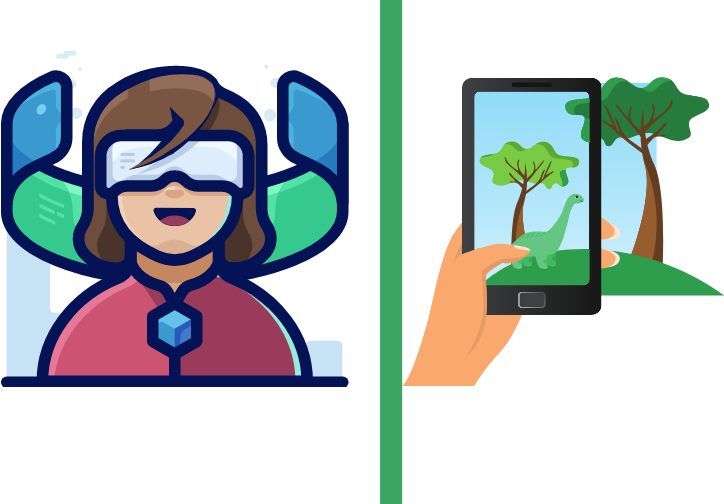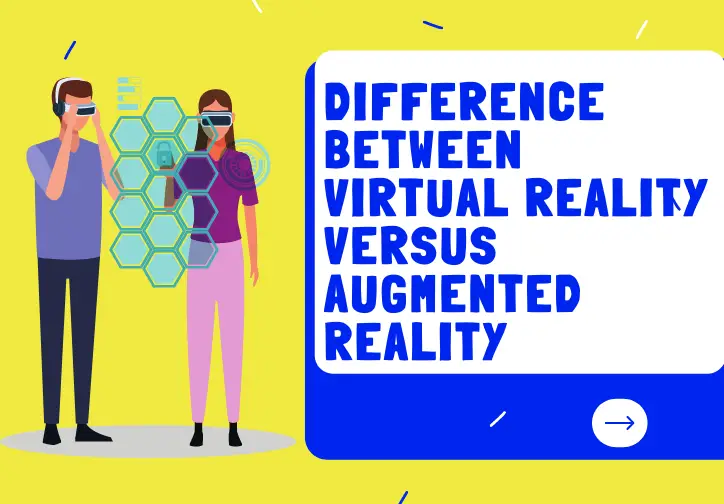Virtual reality and augmented reality are both relatively new technologies, but they have a huge difference in how they work.
Virtual reality completely immerses you in a simulated, computer-generated world whereas augmented reality superimposes digital effects on top of the real world.
The reason virtual reality is more popular than augmented at this point is due to its ability to make people feel like they’re actually there.
What is virtual reality?
Table of contents
Virtual Reality is a computer-generated simulation of a three-dimensional image or environment that can be interacted with in a seemingly physical way by participants who wear headsets and special gloves.
VR uses immersive technologies to create virtual worlds, so people using the products are able to enter into another world.
VR can also allow for interactions between multiple users through chat programs like Skype or Google Hangouts.
Users may not see where one’s hand is when they shake hands because both user’s views will only show their own avatar from different angles. In order to interact with others as if they were physically present, some systems use technology such as Leap Motion (which covers an area equivalent to two tablet screens).
The latest versions of these applications have been developed further still to provide a realistic sense of touch.
VR headsets are usually connected to either PC or console-powered virtual reality systems, with the power often having been provided by an external computer and synchronization handled through a separate device such as Xbox controller, PlayStation Move controllers, or keyboard/mouse setup.
What is augmented reality?
Augmented Reality is a live direct or indirect view of a physical, real-world environment whose elements are supplemented by computer-generated sensory input such as sound, video, graphics, etc.
The most common way this is done in the current time frame (non-VR) is through windows that have been layered with digital information and data.
This type of technology has existed for years but it’s only recently become more feasible to integrate augmented reality into everyday life scenarios due to improved processing power and screen resolutions on mobile devices like smartphones and tablets.
With augmented reality, a person’s current physical environment is overlaid with digital information.
For example, an individual who works at an office building might see AR instructions for how to use the in-building printer when she looks out of her window and sees people walking by on the street below.
The possibilities are endless depending on what type of data one would want to overlay onto his or her immediate surroundings.
Difference between virtual reality versus augmented reality

The major difference between virtual reality and augmented reality is that while VR creates a simulated world, AR superimposes digital content onto the user’s surroundings.
Virtual Reality (VR) requires a headset to be worn in order for it to work
Augmented Reality (AR) can be done with different devices including smartphones or tablets where you hold your device out as if capturing what is around you.
VR has the ability to entirely immerse you in a different world, while AR can only provide an additional layer of visual data on top of what is already there.
When using augmented reality, any movement will disrupt the experience and make it difficult for users to see digital content clearly or at all without refocusing their vision. This problem does not exist with virtual reality because when one moves around they are transported to another place altogether.
Augmented Reality is more social than Virtual Reality since it requires people to interact together in order for the technology to work whereas VR allows people from different geographical locations (or even time periods) to interact through simulated environments no matter where they may be located physically.
A key difference between augmented reality and virtual reality is that augmented reality places digital content over what one already sees, whereas virtual reality generates an entirely new environment.
What is the difference in terms of gaming and entertainment?

Virtual Reality (VR) immerses the player in a computer-generated environment. Augmented Reality (AR) overlays graphics and other information on top of real-world objects.
The first significant difference between VR and AR is how they are experienced. One type requires you to put on something like glasses or headgear, while the other does not require any special equipment beyond what you might use for viewing a screen – just as with watching TV or playing video games.
This means that anyone can experience augmented reality without additional cost whereas some people may need to purchase virtual reality gear before being able to fully enjoy it themselves or share it with others in an enjoyable way.
In addition, because players using this technology will be accessing these environments through their screens, developers can create games that are played in 360 degrees.
What is better VR or AR
VR is generally associated with gaming, while AR is more focused on the industrial market.
AR allows you to see your environment in a new way.
In many ways VR and AR are different but at the same time, they offer similar experiences. For example, both of them produce an immersive experience where it feels like you’re really there, so what’s better? It all depends on your individual needs!
VR is generally associated with gaming, while AR is more focused on the industrial market.
AR allows you to see your environment in a new way. In many ways VR and AR are different but at the same time, they offer similar experiences. For example, both of them produce an immersive experience where it feels like you’re really there, so what’s better? It all depends on your individual needs!
Why would you choose AR over VR
The idea of virtual reality (VR) is to transport the user into a completely new environment, which is often very different from their physical world.
With augmented reality (AR), you can look at this same world as it actually unfolds before your eyes and then be able to interact with it on some level.
The difference between AR and VR means that AR has an advantage when interacting within real-world environments because they are two-dimensional enough for computer graphics rendering software to work with them in order to create meaningful interfaces.
On the other hand, VR may have more applications than just entertainment-based uses such as training programs or simulations for engineering purposes but these types of projects will require plenty of time and funding before anything truly significant comes out of them.
The future of AR/VR technology
The future of AR/VR technology is exciting and filled with possibilities.
One thing to keep in mind, however, is that the two types are not always interchangeable. VR makes you feel like you’re transported into a different world while AR enhances your current reality by adding virtual objects onto what is seen in front of your eyes.
You can think about it as seeing something through glasses that give you more information or show an alternative view than what’s there on its own.
The best way to get acquainted with both worlds is just to try them out for yourself!
Final Words
The difference between virtual reality and augmented reality is a difficult one to grasp.
If you want to get started, we recommend checking out this article from our blog on the topic for some more information or reach out with any questions you may have!

